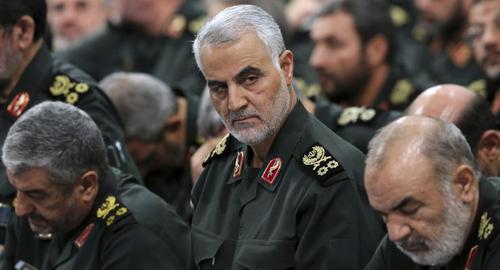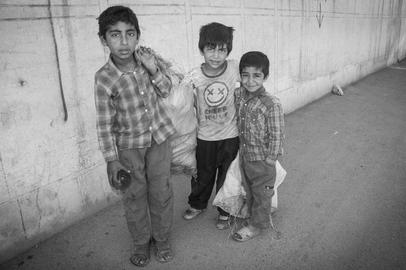When US forces assassinated Ghasem Soleimani, the head of the Revolutionary Guards Quds Force, did they kill a key architect of repeated crackdowns against protesters?
On February 9, the former head of the Islamic Revolutionary Guards Corps (IRGC) praised the “effective measures” Ghasem Soleimani took to suppress popular protests, sending shockwaves across Iran's political landscape. Soleimani, as head of the Quds Force, was tasked with extraterritorial operations and not domestic ones. The suggestion that he had been involved in crackdowns in the past also led to the natural assumption that he might have been involved in the country’s most recent unrest in mid-November 2019.
According to Mohammad Ali Jafari, Soleimani, who was assassinated by US forces in Iraq on January 3, Soleimani was "present at the scene on the street to confront the counter-revolutionaries” during the widespread student protests of 1999 and unrest that followed the disputed presidential election of 2009. Jafari posted his comments on Twitter on Sunday, February 9.
In July 1999, plainclothes agents and police raided a dormitory at Tehran University, attacking and injuring dozens of students, sparking street protests in Tehran
Then, in 2009, plainclothes agents and military forces also lashed out against the peaceful protests that followed the announcement that Mahmoud Ahmadinejad had secured another term, killing at least 30 people and arresting thousands.
The Tehran unit of the Revolutionary Guards played a major role in both suppressions, and now, years on, Jafari has confirmed that Soleimani was at the Guards’ Tehran Saralah Headquarters, and was directly involved in the crackdown.
The Saralah Headquarters is central to the Guards’ operations in Tehran, and was set up in 1995 under the supervision of the Supreme National Security Council to bring security to the province, particularly in times of crisis.
Ali Fazli was one of dozens of Guards commanders whose name has been linked to crackdowns and suppression of citizens’ rights over the last 40 years, including serving as an acting commander of the headquarters from 1997 to 2000, and playing a key role in cracking down on student protests in 1999.
But Jafari’s explicit naming of Soleimani’s role in this notorious incident was unprecedented, revealing the depth and breadth of the commander's impact on Iranian military actions both inside and outside the country, and, by extension, on Iranian society in general.
Split Reactions
The decision to name Soleimani has attracted widespread comment on social media, with clashes between people on opposing sides of the argument.
Pro-Hezbollah activists initially labeled Jafari's tweet to have come from a “fake" account, while others insisted that it was the former commanders' authentic profile.
A few hours after the controversy broke out, Mashregh News, said to be run by the intelligence department of the IRGC, interviewed Ramazan Sharif, a spokesperson for the IRGC, quoting him as saying that "the content of the tweet published is inaccurate and Haj Ghasem had not had any responsibility or presence at the Saralah Headquarters."
Sharif also implicitly described Jafari's remarks as a move to create "a ground for psychological operations against the IRGC.” The comment was removed from the Mashregh News website hours later [Persian link].
The IRGC has so far taken no formal position on Jafari’s comment, and, despite criticism from hardline conservatives and pro-Soleimani reformists alike, the tweet has not been taken down.
Mehdi Nasiri, editor-in-chief of Sobh magazine and a well-known conservative in Iran, posted his response to Jafari's tweet. "Dear Commander! Are you hopeful that those who turned their back will reconcile with the revolution and the regime and the leadership because of the blood of Haj Ghasem?"
Reformist Saeed Shariati also responded to Jafari's tweet, demanding that he show "a photo of Ghasem Soleimani on the street in 2009" in order to prove his claim.
Evidence From Tehran's Former Mayor
Other prominent figures came forward suggesting there was credible evidence that Soleimani had some involvement in the suppression of protests, including former Tehran mayor Mohammad Bagher Ghalibaf, who said, "Perhaps the biggest move to prevent the incident, from Saturday to Thursday, was made by me and Commander Soleimani."
Ghalibaf also cites Soleimani's role, along with a group of 23 other IRGC commanders, in sending a threatening letter to Mohammad Khatami while he was president. Ghalibaf said the letter had been written "by Mr. Soleimani and me.”
Hamid Reza Moghadamfar, a cultural and media adviser to the IRGC, confirmed the draft was prepared by Soleimani.
At the time of the 1999 protests and the letter, Soleimani had only been commander of the Quds Force for two years, and the aggression toward Khatami was hugely controversial. It represented one of Soleimani's most explicit political stances when it came to internal affairs.
Many cited the letter as proof of the Guards' clear intervention in politics, a trend that, critics say, peaked in the 2009 presidential election and continues to this day.
After Mohammad Khatami's tenure as president came to an end in 2005, Soleimani's activities were more focused on missions outside of Iran. From then on, his name was less prominent when it came to discussions about political influence and conflicts. And yet, a review of his comments over the years suggests that his views on domestic affairs were absolutely in line with those of other IRGC commanders."The Iranian people spontaneously thwarted all the seditions, including the 2009 sedition and the recent sedition [January 2018], which was created by the enemy,” Soleimani said in a speech in Kerman in February 2018.
He added: "In these seditions, the counter-revolutionaries intervened and surfed on this wave to try to overthrow the revolution, but the Iranian nation rose up and defeated the enemy."
The recent comments from Jafari, coupled with Soleimani’s historical referencing of protests as “seditions,” suggests he also supported the crackdown on November 2019 nationwide protests in Iran — or even helped to lead them.
On 4 January 2020, US Secretary of State Mike Pompeo suggested Soleimani played a leading role in the operation. "He was in charge of the Basij Forces and was leading them. Soleimani knew that if the voice of the Iranian people were heard, his existence would be in danger."
Following this, the Seda-ye Modafean [Voice of Defenders] website reported that the "Modafean Haram [Defenders of the Shrine]" units had been "forced" to suppress the protests during the November 2019 protests — these units operated under Soleimani’s supervision.
This unprecedented confession is another clear indication of Soleimani's power, not only in Syria, Yemen and Palestine, but also on the streets of Iran.
visit the accountability section
In this section of Iran Wire, you can contact the officials and launch your campaign for various problems

























comments